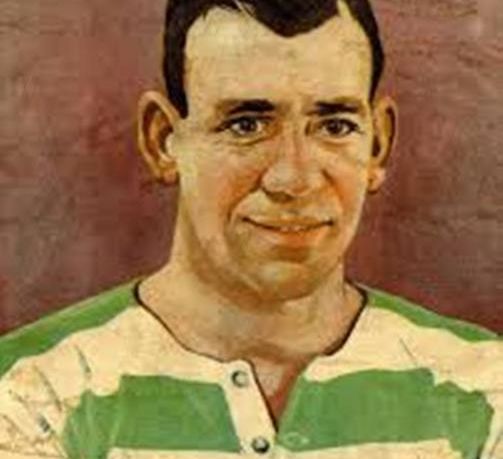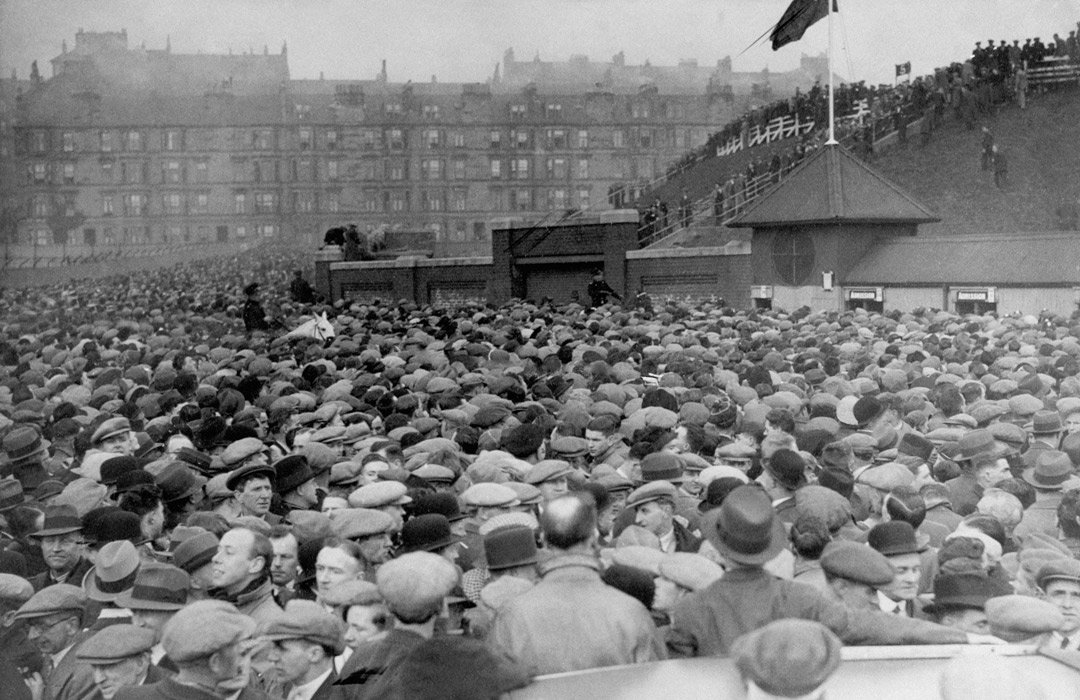According to legend, 1 April 1933 was the day that the Hampden Roar was born, and that Jimmy McGrory was responsible. One feels that this is a little unfair on previous Hampden crowds who, no doubt, made a lot of noise on previous occasions when Scotland beat England or indeed when Patsy Gallacher and Jimmy McGrory scored the goals that beat Dundee in 1925. Maybe even the Roar was born as early as 16 April 1904 when Jimmy Quinn scored his Cup final hat-trick.
But putting all that aside, it seems that 1 April 1933 was the first time that the “Hampden Roar” was so called with housewives in the north of Glasgow affirming that they suddenly heard a mighty roar across the city at about 4.30 pm. that day. Stories that it wakened babies, disturbed the amorous activities of courting couples and even put “hens off the lay” are possibly exaggerated, but it was certainly by all accounts, loud and prolonged like a never ending roar of thunder.
1933 was difficult in Scotland. Unemployment was still high, and there seemed no end to the economic recession.
Ominously in Germany, that funny little man with a moustache had seized power and was already making all the wrong sort of noises about how bad the Treaty of Versailles had been. On the other hand, Glasgow being Glasgow, there was plenty of dancing, cinema (the “talkies” had now arrived) and of course football. In a couple of weeks time Celtic would be back in the Scottish Cup final. It had taken a long time to recover from the death of John Thomson.

Celtic had three representatives in the team – two Peters, (McGonagle and Wilson) and one Jimmy. There were three Rangers – George Brown, Doc Marshall and Bob McPhail, two from Queen’s Park -Bob Gillespie and Jimmy Crawford, one from Hearts – Andy Anderson, one from Partick Thistle – goalkeeper Jakie Jackson, while Dally Duncan of Derby County was the only Anglo in the team. England, as always, had a strong team of Hibbs, Cooper and Blenkinsop; Strange, Hart and Weaver; Hulme, Starling, Hunt, Pickering and Arnold.
It was a fine spring day, and the pipes and drums were there in strength to entertain the early arrivals. The staggering crowd of 134,170 had not all gained admission when Scotland went ahead. It was a very simple tap in by Jimmy McGrory after a Dally Duncan cross which found McGrory unmarked. That was in the fourth minute, but England fought back to score with a deflection from a shot by George Hunt of Tottenham Hotspur. That was only fair, for the game was even.
Gradually, however, in the second half and playing towards the King’s Park End, Scotland, with Peter Wilson absolutely immense and stroking passes all over the field, took command but England still looked to have sufficient defensive capability to resist until the moment that changed it all.

Let Jimmy McGrory himself tell the story of how the Hampden Roar was christened…
“…only eight minutes to go. The surging, inspiring crowd began a cacophony of bedlam as Doc Marshall of Rangers won the ball on our 18 yard line. He drew his man beautifully and sent the ball across to Bob McPhail who beat two men and cut into the centre. I sensed the move in a twinkling and raced to the inside left position just in time to pick up McPhail’s inch perfect pass. The England full back Tom Cooper advance to tackle, but I shoved the ball past him and summoned the legs to chase after it as the bedlam of the crowd shaped itself into a mighty roar of anticipation. Keeper Harry Hibbs came out in a bid to narrow the angle but I gave the shot everything I had and the ball fairly exploded behind him. So did the crowd. I have never known anything like it. Often on the park I was very conscious of the crowd but this time it was quite impossible to ignore it…One paper reported that men came hurtling down the passageways as if shot from a catapult when I scored”
It was McGrory’s greatest Scotland moment. He would have many such moments for Celtic, but it remains one of the biggest mysteries in Scottish football why Jimmy McGrory was never chosen by Scotland to go to Wembley.
Scotland lost at Wembley in 1930, 1932 and 1934. It is hard to believe that the Golden Crust would not have made a difference. Even in his record goal scoring season of 1936, he was not given the nod. Can anyone tell me why?
It is hard to believe any stories of discrimination, for other Celtic players were chosen. The answer can only lie in the madness of the Selectors.
David Potter



